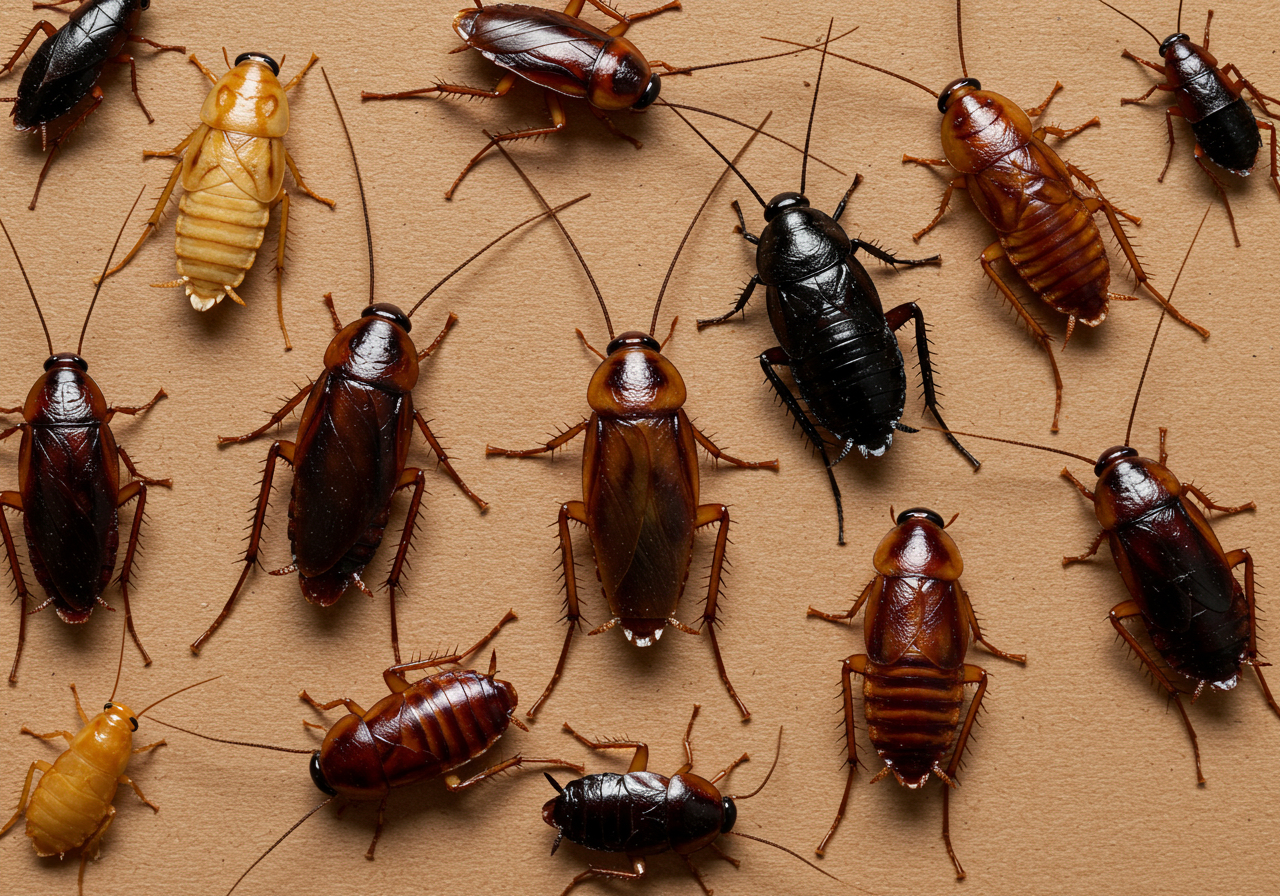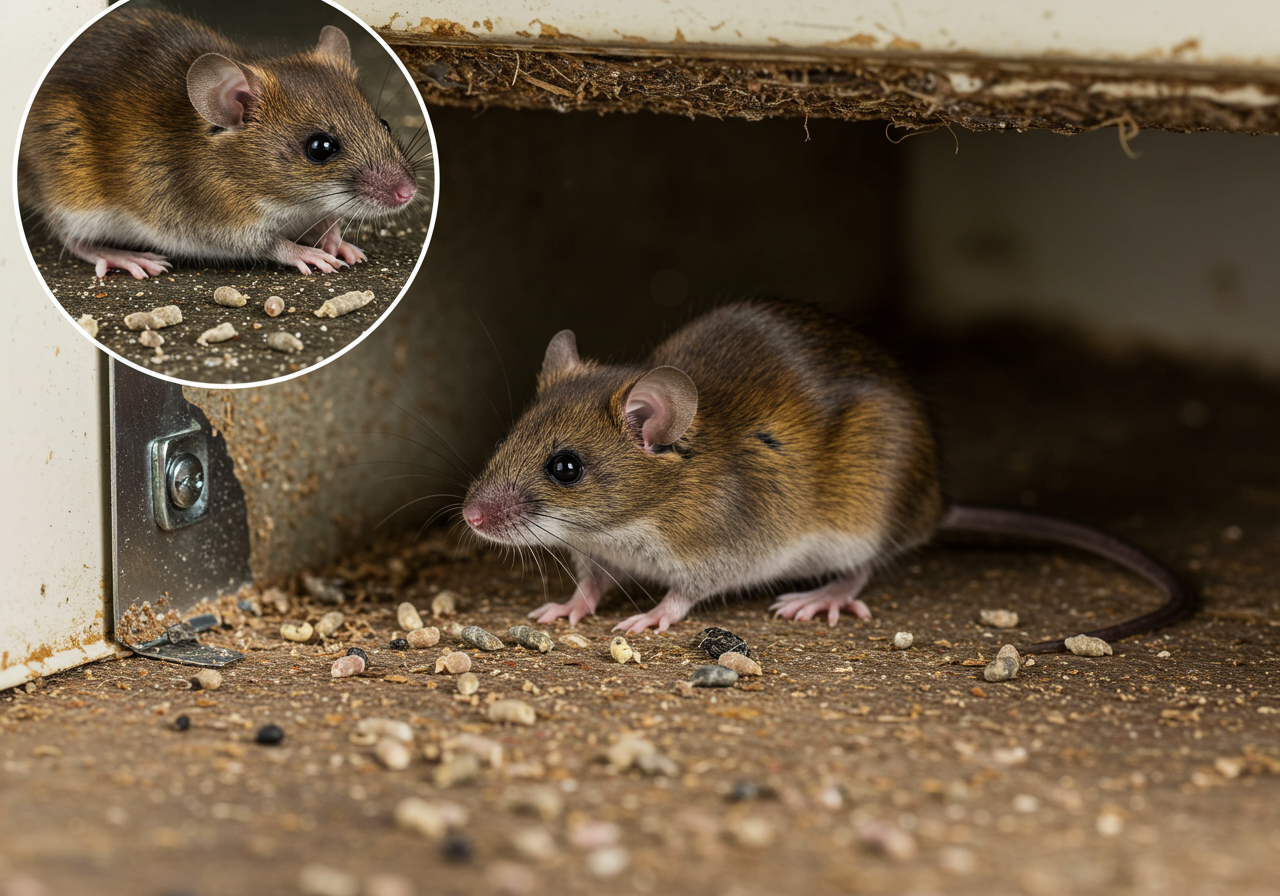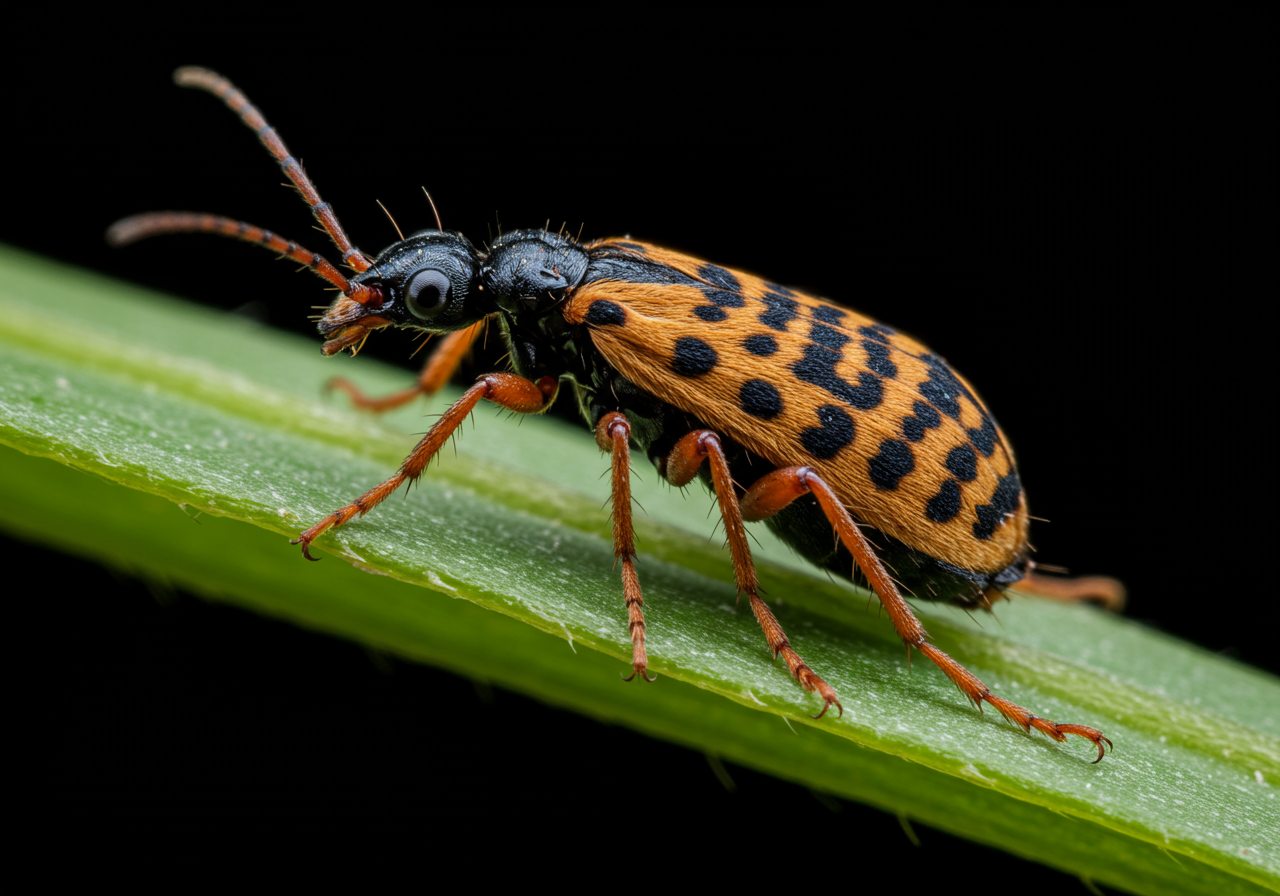
Cockroach Identification in NJ: Spot & Stop Infestations
Cockroaches are unwelcome guests. Don't let them take over your New Jersey home! This essential guide helps homeowners like you easily identify the most common roach species in NJ – including German, American, Oriental, and brown-banded cockroaches. Learn to recognize their unique appearance, typical hiding spots, and crucial infestation signs like droppings and egg cases. Understanding these differences is your first step to effective pest control. Serving Ocean and Monmouth Counties, Resolve Pest Management is here to provide professional, targeted solutions when you need expert help.
Know Your Enemy: A Homeowner's Guide to Identifying Cockroaches and Infestation Signs in New Jersey
Cockroaches are unwelcome guests in any home, but knowing which type you're dealing with is the first step toward showing them the door for good. These resilient pests come in various shapes and sizes, and how they behave and where they like to hide can differ greatly from one species to another. For homeowners and businesses across New Jersey, especially in areas like Ocean and Monmouth Counties, recognizing these differences can make all the difference in quickly resolving a roach problem and protecting your family's health and property.
This guide will help you understand the most common cockroach species found in our state, showing you how to spot German, American, Oriental, and brown-banded cockroaches. We'll also dive into the tell-tale signs of a cockroach infestation you should watch for, arming you with the knowledge to decide if a few sanitation changes, some DIY efforts, or a professional pest control service is your best next step.
What Are the Most Common Cockroach Species in New Jersey?
New Jersey is home to several common cockroach species, each with unique characteristics that influence how and where infestations begin and spread. Accurately identifying the species helps homeowners and businesses in Ocean and Monmouth Counties choose the right treatment because each roach has different habits—from where they lay eggs to their favorite damp or dry hiding spots.
Understanding these differences is crucial for effective prevention and control. Here's a quick rundown of the primary species you might encounter and a simple trait to help you recognize them:
- German cockroach: Small, light brown, with two dark stripes behind its head. Often found in kitchens.
- American cockroach: Large, reddish-brown, and commonly seen in basements and sewers.
- Oriental cockroach: Shiny dark, moves slowly, and loves damp, cool places like drains.
- Brown-banded cockroach: Small, with light bands across its back, prefers dry, elevated spots.
For a clearer comparison, here’s a table summarizing their key features:
| Species | Size | Color | Distinguishing Feature | Typical Habitat |
|---|---|---|---|---|
| German cockroach | 1/2 to 5/8 inch | Light brown | Two dark parallel stripes on the shield behind its head. | Kitchens, behind appliances, restaurant equipment. |
| American cockroach | 1.5 to 2 inches | Reddish-brown | Large size; sometimes a figure-8 pattern behind its head. | Sewers, basements, commercial buildings. |
| Oriental cockroach | 1 to 1.25 inches | Shiny dark brown to black | Robust, slow-moving; females have very short, stubby wings. | Damp basements, drains, leaf litter. |
| Brown-banded cockroach | 1/2 inch | Brown with light bands | Light bands across its wings/back. | High cabinets, furniture, electronics, dry areas. |
This table is a handy tool to help you match what you've seen to the likely species. Getting the identification right saves you time and effort and ensures you’re not trying to solve a problem with the wrong approach. When precise identification is needed, Resolve Pest Management offers professional identification and customized cockroach control for homes and businesses in Ocean and Monmouth Counties. Our local technicians use species-specific inspection methods to pinpoint the source of your infestation.
Which Cockroach Species Are Found in Ocean and Monmouth Counties?
In Ocean and Monmouth Counties, German and American cockroaches are the most commonly reported species. You might also encounter Oriental and brown-banded cockroaches, depending on where you live and the time of year. Our coastal humidity and the mix of urban areas, older homes, and bustling businesses create perfect conditions for these pests. Restaurants, multi-family housing, and older basements and sewers are frequent spots for roach sightings. Brown-banded roaches, however, tend to prefer drier, heated indoor areas.
It's also worth noting that as temperatures drop, outdoor American cockroaches might seek warmth inside your home. German cockroaches, on the other hand, can thrive indoors all year long in heated buildings. Knowing these local patterns helps us prioritize inspection areas and prevention tactics for properties across New Jersey.
How Do German, American, Oriental, and Brown-Banded Cockroaches Differ?
Knowing the differences between these common roach species is key to effective pest control. German cockroaches, for instance, love to hide in tiny kitchen cracks and multiply very quickly. American cockroaches often come in from outside, requiring control methods focused on your home's perimeter and sewer systems. Oriental cockroaches need you to tackle moisture problems, while brown-banded roaches demand a thorough check of high-up, dry hiding places.
Beyond size and color, which are quick visual clues, their egg case placement and how their young behave can tell you where the next generation is growing. These biological differences help pest control experts decide whether to focus on baits, perimeter treatments, moisture control, or sealing up cracks in your home. Understanding these distinctions helps avoid wasted effort and speeds up getting rid of them.
How Can You Identify the German Cockroach?
The German cockroach is a small, fast-breeding indoor pest. You can spot it by its light brown color and two dark stripes running parallel behind its head. It loves warm, damp places near food and water, often hiding in tiny cracks, inside appliances, and behind baseboards. If you see them, especially during the day, it often means you have an established infestation because they reproduce so quickly.
German cockroaches can carry bacteria and trigger allergies, so quick action is important to reduce health risks. Correctly identifying this species guides us toward specific solutions like baits, traps, and sealing entry points, rather than less effective, general approaches.
What Are the Key Appearance Features of the German Cockroach?
Adult German cockroaches are typically about 1/2 inch long and are light tan to medium brown. Their most defining feature is the two distinct dark stripes running lengthwise on the shield-like area behind their head (called the pronotum). Young German roaches (nymphs) are wingless, darker, and smaller, often found near egg cases and food. Adults have short wings and move very quickly when disturbed. These visible traits—size, stripe pattern, and the color of their young—are practical clues during an initial check.
Where Does the German Cockroach Typically Live and Hide?
German cockroaches are drawn to kitchens, food prep areas, inside appliances, and other warm spots where there's humidity and leftover food crumbs. They squeeze into small cracks, behind stoves, under sinks, and inside cabinets. Because they prefer to live in clustered, hidden spots, inspections should target appliance seals, wall cracks, and crevices near plumbing. Good sanitation and managing moisture can help, but because they hide so well, careful inspection and monitoring are crucial. Finding young roaches or egg cases in these areas is a clear sign that you need more aggressive action.
What Health Risks Does the German Cockroach Pose?
German cockroaches are more than just a nuisance. They can carry bacteria on their bodies and in their droppings, contaminating food and surfaces. They also shed allergens that can worsen asthma and allergic reactions, especially in children and sensitive individuals. Their rapid breeding means that bacterial and allergen levels can quickly increase in infested buildings, posing a significant public health concern for homes, apartment complexes, and food businesses. Controlling these populations helps reduce these health risks. Early identification and action protect both your health and your property.
Dealing with an established German cockroach problem often requires professional help due to their quick breeding and hidden living habits. Resolve Pest Management provides targeted cockroach control services specifically designed for German cockroaches, combining thorough inspection, monitoring, and specialized treatments to effectively reduce populations in your Ocean and Monmouth County property.
What Are the Distinctive Characteristics of the American Cockroach?
The American cockroach is the largest common indoor roach in New Jersey, easily recognized by its size and reddish-brown color. While it prefers warm, damp outdoor shelters, it will enter basements, sewers, and buildings looking for food or mates. Its size and color offer quick identification, and its behavior—moving from sewers and crawlspaces into buildings—helps inspectors pinpoint entry points. Since adult American cockroaches can glide or fly short distances in warm weather, seeing them on upper floors usually means there's a significant infestation nearby or an easy way into your building. Recognizing these traits helps direct control efforts toward sealing up entry points, improving sanitation, and sometimes even treating sewer lines.
How to Recognize the American Cockroach’s Size and Color?
American cockroaches are quite large, typically measuring 1.5 to 2 inches long. They are reddish-brown, and some may have a lighter margin or a distinctive figure-8 pattern on the shield behind their head. Their large size is the fastest way to identify them. Adult wings fully cover their abdomen, which helps distinguish them from the smaller, wingless young of other species. Accurate size and color recognition helps determine whether to focus on indoor treatments or on modifying outdoor habitats.
What Habitats Do American Cockroaches Prefer in NJ?
American cockroaches thrive in sewers, boiler rooms, mulch, leaf litter, and commercial loading docks—any moist outdoor habitat. In urban areas of New Jersey, old sewer systems and lots of organic debris contribute to their presence. They often use drains and gaps in foundations to get into buildings, favoring basements, boiler rooms, and food storage areas once inside. Managing outdoor moisture and sealing cracks in your home’s foundation can help prevent them from coming indoors. For businesses, focusing on outdoor breeding sites often leads to better long-term control than only treating indoors.
Can American Cockroaches Fly and How Does That Affect Identification?
Yes, adult American cockroaches have fully developed wings and can glide or even fly short distances, especially in warm, humid conditions. This can be startling to homeowners who aren't expecting a flying roach! If you see them flying, it's a strong indicator of mature adults and active populations nearby. Reports of flying roaches should prompt a broader inspection for entry points and outdoor hiding spots. Observing flight also helps tell American cockroaches apart from Oriental and German species, which rarely fly in typical home settings.
How to Identify Oriental and Brown-Banded Cockroaches?
Oriental and brown-banded cockroaches differ significantly in their preferred environments and hiding habits. The Oriental cockroach loves damp, cool spots and is often called a "water bug," while the brown-banded cockroach prefers warm, dry, and elevated hiding places and moves through structures differently. Visual cues—shiny dark coloring for Oriental and pale bands for brown-banded—help with quick identification. Because they prefer different micro-habitats, inspections need to cover everything from basements and drains to high cabinets. Correct identification ensures that any pest control efforts are targeted and effective.
What Does the Oriental Cockroach Look Like and Where Is It Found?
Oriental cockroaches are 1 to 1.25 inches long, shiny dark brown to black, and move much more slowly than other species. Females often have very short wings and cannot fly. They are most commonly found in cool, damp basements, drains, and hidden spaces connected to sewers where moisture and organic matter collect. Finding adults near floor drains or in damp crawlspaces strongly suggests an Oriental roach presence and highlights the need for moisture reduction and sealing drains as primary solutions.
Why Is the Oriental Cockroach Called a “Water Bug”?
The nickname "water bug" comes from the Oriental cockroach's strong preference for wet environments—think sewers, drains, and soggy basements. This love for moisture explains where you typically find them and means that leaky pipes, standing water, and poor drainage are major risk factors. Fixing these moisture issues and improving drainage will reduce Oriental cockroach populations much more effectively than just using indoor baits.
What Are the Appearance and Habits of the Brown-Banded Cockroach?
Brown-banded cockroaches are small, about 1/2 inch long, with light bands across their wings or abdomen. They tend to hide in high, dry places away from food areas. They often glue their egg cases to surfaces and hide inside electronics, picture frames, and high-up furniture cracks, making them challenging to spot. Because they prefer warm, dry spots, control efforts should focus on inspecting elevated areas thoroughly and applying treatments carefully where allowed. Seeing small, banded roaches in areas other than the kitchen often points to this species.
Where Do Brown-Banded Cockroaches Prefer to Hide?
Brown-banded roaches love high, warm, dry spots like inside cabinets, behind wallpaper, within electronics, and in furniture joints. This protects them from many pest control methods typically aimed at kitchens. Their tendency to hide in such a wide variety of elevated, concealed places requires a very thorough inspection beyond just the usual kitchen spots. Treatment plans should include targeted dusts or baits in these hidden elevated areas and consistent monitoring. Since they glue their egg cases to surfaces, inspections should also include checking behind trim, inside clocks, and inside appliances.
What Are the Common Signs of a Cockroach Infestation?
Cockroach infestations make themselves known through live sightings, droppings, egg cases (oothecae), smear marks, and distinct odors. Spotting these signs early allows for a quicker response and reduces health risks. Droppings look different for each species—like fine pepper for German roaches or larger pellets for American roaches. The shape and location of egg cases also help confirm the species and how far along the infestation is.
Here’s a practical list of the most important signs to look out for during your own inspections:
- Live Sightings: Seeing multiple active roaches, especially during the day, suggests a significant infestation.
- Droppings: Small, black, pepper-like specks behind appliances or in drawers often mean German roaches. Larger, cylindrical pellets near basements or sewers point to American roaches.
- Oothecae (Egg Cases): These are brown, capsule-like cases, usually hidden in cracks or glued to surfaces. Their presence indicates active breeding.
- Smear Marks / Grease: Dark streaks on baseboards or around drains can signal heavy infestations.
- Musty or Oily Odor: A persistent, sweet, or oily smell can indicate a large, long-term infestation.
This table helps you quickly identify signs and figure out if you need to clean, seal entry points, or call in professionals. When you see multiple signs together—especially egg cases and active young roaches—a professional inspection is strongly recommended.
If you confirm multiple signs of an infestation, or if odors and egg cases continue to appear, contact Resolve Pest Management for an inspection and treatment plan. Our technicians will assess the species, map out where they are hiding, and recommend targeted control specifically for properties in Ocean and Monmouth Counties. Getting professional help early can limit health risks and stop you from wasting time on ineffective DIY attempts.
How to Identify Cockroach Droppings and Egg Cases?
Cockroach droppings vary by species: German cockroach droppings look like fine black pepper or coffee grounds, while American roach droppings are larger, cylindrical pellets. Egg cases (oothecae) are tough, brown capsules, roughly 6–9 mm for German roaches and larger for other species. You’ll often find them tucked into cracks, behind appliances, or glued to surfaces. Always check common hiding spots like behind refrigerators, inside drawers, and near drains for these signs. Finding egg cases is a clear sign that roaches are reproducing and a comprehensive control plan is needed.
What Odors Indicate a Cockroach Problem?
A musty, oily, or slightly sweet smell can point to a heavy or long-standing cockroach infestation. This smell comes from their pheromones (chemical signals), secretions, and a buildup of droppings and shed skins. The stronger the odor, the larger and older the infestation likely is, often meaning that simple cleaning isn't enough. If you notice a distinct cockroach odor, expand your inspection to hidden areas and consider a professional assessment. Getting rid of the odor requires not only eliminating the insects but also thoroughly cleaning contaminated surfaces.
When Should You Call a Professional Exterminator?
It's time to call a professional when you spot multiple live roaches, find egg cases or clusters of young roaches, experience health issues like worsening asthma symptoms, or if your DIY efforts haven't worked after a short try. These are all clear warnings that you have an established infestation that requires targeted pest control.
Professionals, like those at Resolve Pest Management, will accurately identify the species, locate their hiding spots, and use integrated strategies. This includes providing sanitation advice, sealing entry points, monitoring their activity, and applying targeted treatments tailored to the specific biology of the cockroaches found in your home or business.
For residents and businesses in Ocean and Monmouth Counties, contacting Resolve Pest Management ensures you get an inspection-driven plan with follow-up monitoring for lasting control. We offer comprehensive Roach Control services, including Commercial Pest Control for businesses, 24-Hour Emergency Pest Control for urgent situations, and ongoing Seasonal Pest Protection Plans. Our commitment to providing effective, family- and pet-friendly solutions, backed by our S.T.I.N.G. promise (Service, Trust, Initiative, Nurture, and Grit), means you can trust us to resolve your pest problems.
Don't let cockroaches take over your home or business. Call us today at (732) 527-5770 or visit our website to schedule a species-focused inspection and start your tailored treatment plan with Resolve Pest Management. We are available 24/7 to help you.
More Blogs
Some other blogs you might be interested in



